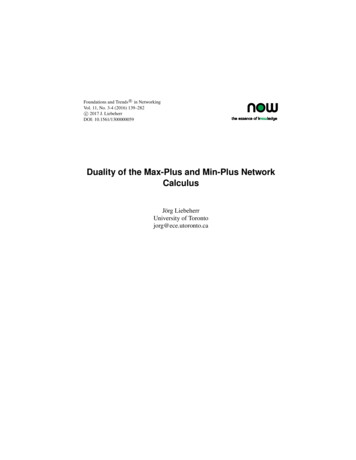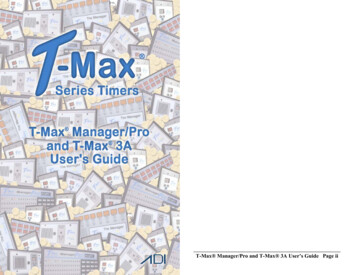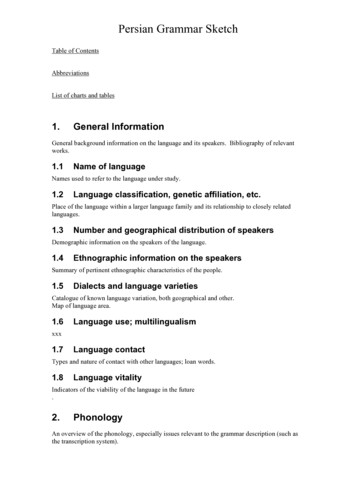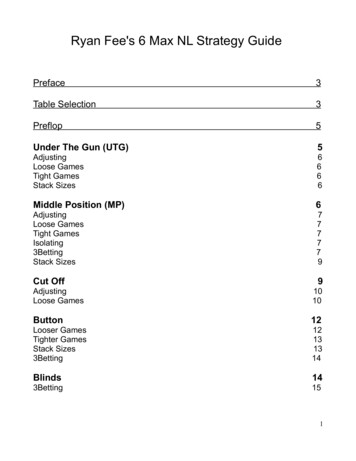
Transcription
Foundations and Trends R in NetworkingVol. 11, No. 3-4 (2016) 139–282c 2017 J. LiebeherrDOI: 10.1561/1300000059Duality of the Max-Plus and Min-Plus NetworkCalculusJörg LiebeherrUniversity of Torontojorg@ece.utoronto.ca
Contents1 Introduction1402 Motivation1443 Modelling Traffic Arrivals in the Space Domain1474 Max-Plus Algebra of Functions1535 Backlog and Delay in the Space Domain1596 Max-Plus Traffic Envelopes and Traffic Regulators1657 Service Curves in the Max-Plus Network Calculus1717.1 Max-plus service curves . . . . . . . . . . . . . . . . . . 1717.2 Residual max-plus service curves . . . . . . . . . . . . 1737.3 Strict and adaptive max-plus service curves . . . . . . . 1778 Performance Bounds1849 A Summary of the Min-Plus Network Calculus189ii
iii10 Isomorphism between Min-Plus and Max-Plus Algebra19610.1 Properties of pseudo-inverse functions . . . . . . . . . . 19810.2 Mapping of algebras . . . . . . . . . . . . . . . . . . . . 20511 Min-plus and Max-plus Duality in the Network Calculus11.1 Mapping of traffic envelopes . . . . . . . . . . . . . . .11.2 Mapping of service curves . . . . . . . . . . . . . . . .11.3 Mapping of performance bounds . . . . . . . . . . . .11.4 Mapping of backlog and delay . . . . . . . . . . . . . .11.5 Mapping of busy periods and busy sequences . . . .21121121222022122812 Scheduling for Rate and Delay Guarantees12.1 Earliest Deadline First in the max-plus algebra . .12.2 Max-plus Service Curve Earliest Deadline First . .12.3 Max-plus SCED with adaptive service guarantees12.4 Proof of Theorem 12.8 . . . . . . . . . . . . . . . .12.5 Traffic shaping . . . . . . . . . . . . . . . . . . . .232233237248253259.13 Related Literature26214 Conclusions269Appendices271A Proofs of Lemma 4.1 and Lemma 4.2272References280
AbstractThe network calculus is a framework for the analysis of communication networks, which exploits that many computer network models become tractablefor analysis if they are expressed in a min-plus or max-plus algebra. In amin-plus algebra, the network calculus characterizes amounts of traffic andavailable service as functions of time. In a max-plus algebra, the network calculus works with functions that express the arrival and departure times or therequired service time for a given amount of traffic. While the min-plus network calculus is more convenient for capacity provisioning in a network, themax-plus network calculus is more compatible with traffic control algorithmsthat involve the computation of timestamps. Many similarities and relationships between the two versions of the network calculus are known, yet theyare largely viewed as distinct analytical approaches with different capabilities and limitations. We show that there exists a one-to-one correspondencebetween the min-plus and max-plus network calculus, as long as traffic andservice are described by functions with real-valued domains and ranges. Consequently, results from one version of the network calculus can be readilyapplied for computations in the other version. The ability to switch betweenmin-plus and max-plus analysis without any loss of accuracy provides additional flexibility for characterizing and analyzing traffic control algorithms.This flexibility is exploited for gaining new insights into link scheduling algorithms that offer rate and delay guarantees to traffic flows.J. Liebeherr. Duality of the Max-Plus and Min-Plus Network Calculus. Foundations andTrends R in Networking, vol. 11, no. 3-4, pp. 139–282, 2016.DOI: 10.1561/1300000059.
1IntroductionNetwork calculus is a methodology for performance evaluation of communication networks that expresses the analysis of networks in a min-plus or maxplus algebra. In these algebras, the conventional addition and multiplicationoperations are replaced by the minimum or maximum operation, respectively,and addition. On the one hand, algebras with a minimum or maximum operation have weaker properties than algebras endowed with an addition and amultiplication. For instance, the minimum and the maximum do not have inverse operations. On the other hand, taking minimums and maximums createsstrong ordering properties that can be analytically exploited. Network algorithms that involve sequencing of traffic, e.g., scheduling with a sorted queue,or ordering of events, e.g., window flow control, can often be described bylinear systems in a min-plus or max-plus algebra, but are non-linear in analgebra with addition and multiplication.The deterministic analysis of networks by Cruz in [13, 14] and its application to Generalized Processor Sharing scheduling by Parekh and Gallager in[28, 29] mark the beginning of network calculus research. The research wasmotivated by the emergence of communication networks that provide serviceguarantees even in adversarial worst-case scenarios. Within a few years, researchers recognized that non-traditional algebras, so-called dioids, for mod-140
141elling discrete-event dynamic systems [3] can provide the foundation for asystems theory for communication networks [1, 6, 8]. The dioid algebras areapplied to non-decreasing functions that represent cumulative arrival, departure and service processes in a network. The essence of the systems theory isthat the departure traffic at a network element can be characterized by a convolution of functions describing the cumulative arrivals and the available service. The convolution operation is performed either in a min-plus or max-plusdioid algebra, leading to the min-plus and max-plus versions of the networkcalculus. Detailed models have been developed for many types of networkelements, such as buffered links with FIFO or more complex scheduling algorithms, delay elements, traffic regulators, and many more. Comprehensivediscussions can be found in textbooks on the topic [7, 9].Network calculus analysis can select either a min-plus or max-plus algebra setting, yet, overwhelmingly, the literature presents derivations in a minplus framework. In such a setting, arrivals and departures are represented asfunctions of time, where a function value F (t) represents the amount of arriving or departing traffic until time t. This representation is convenient whenperforming computations with multiplexed traffic flows, since an aggregateof traffic flows that are characterized by functions F1 (t), F2 (t), . . . , FN (t)Pis simply the sum j Fj (t). Expressions for multiplexed traffic flows areneeded when determining capacity requirements for a network, e.g., the maximum number of flows that can be supported in a network subject to givenservice requirements. The representation of traffic by functions of time is lessideal when describing network control algorithms that assign timestamps totraffic. An example is a traffic regulator that determines the earliest time whena packet can be admitted to a network, or a scheduling algorithm that assignsdeadlines for the departure time of packets. Obtaining timestamps from afunction of the form F (t) requires to solve an inverse problem. In a max-plusframework, arrivals and departures are characterized by functions F (ν) thatgive the arrival time or departure time of the ν-th bit or packet. For example, at a traffic regulator, the timestamp that determines when the ν-th bit orpacket can be admitted is simply the value of the departure time function at ν.On the other hand, expressions for multiplexed traffic in the max-plus algebraare cumbersome (as we will see in §3).Ideally, network analysis should be able to reconcile the advantages of the
142Introductionmin-plus and max-plus network calculus algebras. That is, it should be ableto employ functions F (ν) when working with network mechanisms involving timestamps and functions F (t) when multiplexing traffic. Such mix-andmatch computations require that the functions F (t) and F (ν) can be relatedto each other. Mappings between expressions in the min-plus and max-plusnetwork calculus, and vice versa, exist in the literature (see §13), however,since the mappings are (generally) not one-to-one, performing them comesat a loss of accuracy. At present, the prevailing view is that “many concepts[of the min-plus algebra] can be mirrored in the max-plus algebra,” [20, p.63], but also that not every result in the min-plus algebra can be extended toa max-plus setting [9, Remark 6.2.7] and that there is a lacking correspondence between concepts in the min-plus and max-plus algebra [7, §1.10].On the other hand, according to dioid theory, the underlying min-plus andmax-plus algebras of integer or real numbers are isomorphic [3, 21]. Thus,the question arises why the isomorphism does not extend to the min-plus andmax-plus network calculus, which are based on these algebras? Our objectiveis to explore this question. We find that there exists a one-to-one relationshipbetween the min-plus and max-plus network calculus, as long as both approaches are using functions that have a real-valued, that is, continuous-timeor continuous-space, domains. Some of the previously observed differencesbetween max-plus and min-plus analysis can be traced to the use of functionswith a discrete-valued domain. After establishing the duality between the twoversions of the network calculus, we proceed to characterize scheduling algorithms with rate and delay guarantees by service curves of the networkcalculus.The remainder is structured as follows. In §2, we show that the max-plusconvolution operation emerges when we describe the departures at a workconserving link in terms of the arrivals and the link capacity. We observethat the expression for the departures is sensitive to the choice of measuring traffic in discrete units (bits, bytes, or packets) or by a real-valued metric. In §3–8, we present a self-contained description of the max-plus networkcalculus. In §9, we summarize the definitions and main results of the minplus network calculus, which are later used for comparisons between the twonetwork calculus versions. In §10, we show that the min-plus algebra andmax-plus algebra for non-decreasing functions endowed with a minimum (or
143maximum) and a convolution operation are isomorphic to each other. We usethe isomorphism in §11 to establish a duality of service curves, traffic envelopes, and performance bounds. In §12, we express scheduling algorithmsfor rate guarantees in terms of the continuous-space max-plus network calculus, and establish a connection between well-known scheduling algorithmsand expressions in the max-plus algebra. In §13, we discuss the related literature with a focus on prior work on the max-plus network calculus, existingmappings between the min-plus and max-plus network calculus, and its relationship to lattice theory. We present conclusions in §14.
2MotivationConsider a work-conserving buffered link with a fixed transmission rateof C bits per second, as shown in Figure 2.1, which experiences arrivals ofa sequence of packets. Arrivals that exceed the transmission rate are storedin a First-In-First-Out (FIFO) buffer, and become the backlog of the bufferedlink. A work-conserving buffered link transmits at rate C as long as there isa backlog in the buffer.Let TAp (n) and n denote the arrival time and the size (in bytes or bits),respectively, of the n-th packet. The departure time of the n-th packet at thebuffered link, denoted by TDp (n), is determined by adding the transmissiontime Cn of the packet either to its arrival time or the departure time of theArrivalsCDeparturesBacklogFigure 2.1: Work-conserving buffered link with rate C.144
145previous packet, whichever occurs later. We can write this asTDp (n) max TAp (n), TDp (n 1) n,C(2.1)with TDp (0) 0. If we expand the recursion in the expression, we obtain n 1 n n, TAp (n 1) ,CC 1 . . . n o. . . , TAp (1) Cn n k . . . n op max TA (n k) .0 k n 1CnTDp (n) max TAp (n) (2.2)We now perform a change of units, where, instead of marking the arrivals anddepartures of packets, we track individual bits. We use TA (ν) and TD (ν),respectively, to denote the arrival and departure times of the ν-th bit in thepacket sequence, where ν 0 is the first bit in the sequence. If we expressthe recursion of (2.1) using a bit-level description, we obtain for ν 0 that TD (ν) max TA (ν), TD (ν 1) 1,C(2.3)where we set TD (ν) for ν 0. Expanding the recursion results in12νo, TA (ν 1) , . . . , TA (0) CCC κ 1 max TA (ν κ) .(2.4)κ 0,1,.,νCnTD (ν) max TA (ν) Suppose we introduce an operation for two functions f and g such thatf g(ν) max {f (ν κ) g(κ)} ,κ 0,1,.,νand define a function γS (ν) ν 1C .Then we can write (2.4) asTD (ν) TA γS (ν) .(2.5)We refer to the operation as max-plus convolution. Alternatively, definingγS0 (ν) Cν , the departure time can be characterized asTD (ν) TA γS0 (ν) 1.C(2.6)
146MotivationIn a bit-level description of packetized arrivals, all bits belonging to the samepacket arrive instantaneously. If we denote the cumulative size of the first nPpackets by Ln , with Ln nj 1 j and Lo 0, the arrival times of the bitsof the n-th packet are given byTA (Ln 1 ) TA (Ln ln 1) . . . TA (Ln 1) ,for each n 1. The departure time of a packet in a bit-level description is thedeparture time of the last bit of the packet, so that TDp (n) TD (Ln 1) forthe n-th packet. With packetized arrivals and departures, the departure timeof the n-th packet, expressed with (2.5), isTD (Ln 1) TA γS (Ln 1) ,which is identical to the packet-level expression in (2.2).The convolution expressions in (2.5) and (2.6) contain a discretizationartifact due to the bit-level description. In (2.5), a term C1 is added to theservice function, and in (2.6), the departure time TD (Ln 1) is increased bythe same amount. To observe the artifact, consider that the unit in which wemeasure traffic is k1 -th of a bit. Then, the recursion in (2.3) and (2.4) becomes 1TD (Ln k1 ) max
plus network calculus, which are later used for comparisons between the two network calculus versions. In §10, we show that the min-plus algebra and max-plus algebra for non-decreasing functions endowed with a minimum (or. 143 maximum) and a convolution operation are isomorphic to each other. We use the isomorphism in §11 to establish a duality of service curves, traffic en-velopes, and .











